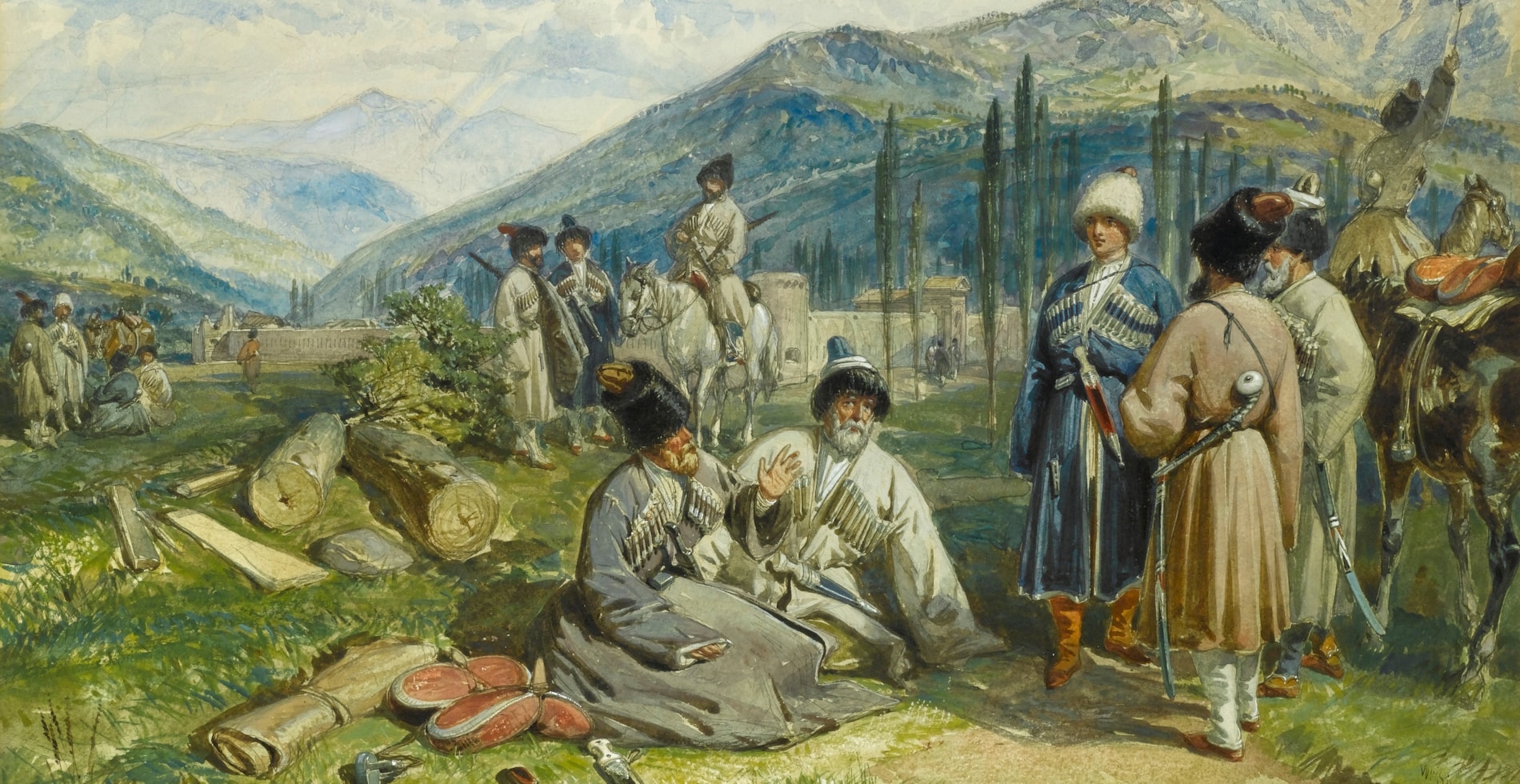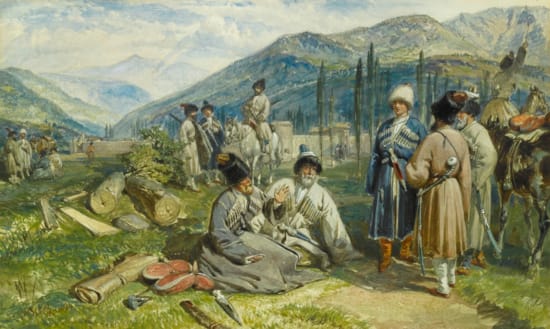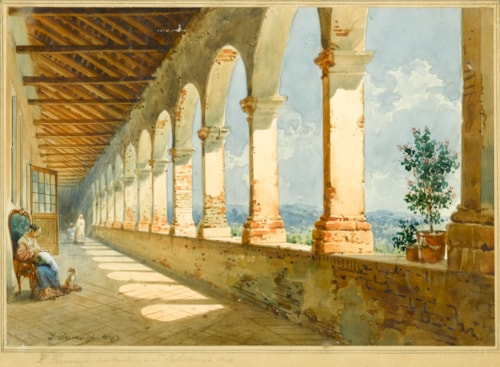illiam Simpson
(Glasgow 1823 - 1899)
Circassians at the Fort of Waia, 8th October 1855
inscribed 'Circassians at the Fort of Waia/ 8th Octr 1855' (lower left), signed and dated 'Wm Simpson/ 1858' (lower right)
pencil and watercolour on paper
25.4 x 42.6 cm (10 x 16¾ in)
William Simpson fills this watercolour on many levels, drawing our eye in to observe and appreciate the intricate detailing and the attention he has paid to both the clothing of the Circassians and the architecture of the fort. There are four principle groupings, which are arranged in such a way as to create a harmonious composition. By placing them on different planes Simpson creates depth, whilst also adding to the sense of perspective. This perspective is further heightened by the alignment of the kindjal dagger and its sheath in the foreground, which follows through to the trunks of the fallen trees, and in turn leads our eye further back to the Fort of Waia, and to the distant, bluish tinged, snow-capped mountains beyond.
Simpson’s Circassians at the Fort at Waia, 8th October 1855 documents part of his trip to Circassia in 1855 with Henry Pelham, Fifth Duke of Newcastle (1811-1864). Simpson had been the Duke’s guide in the Crimea (the artist took the former Minister of War on a tour of the battlefields), and was subsequently requested to accompany him on a tour of Circassia to make sketches. The party, which included the Duke's servant Lucca, the writer Laurence Oliphant (1829-1888) and the marine artist, Oswald Brierly (1817-1894), sailed on 29th September 1855 on HMS Highflier, shortly after the Fall of Sebastopol. They travelled in Circassia with a large group of fiercely patriotic Circassians, who showed themselves still keen to drive out the remnants of the Russian forces, who were occupying a few of the otherwise abandoned forts.
A record relating to this particular part of the Duke’s trip notes: ‘At Waia, a small place on the coast, he [the Duke] took on board at his request the Naib, “priest, prophet, and prince” among the Circassians, together with one hundred followers - a matter of difficulty, as the surf was high... though happily no one was drowned. The Naib had recently been engaged in several battles with the Russians, of which he gave the Duke an account.’¹
Though we have no further details relating to this particular fort at Waia, it is representative of the numerous forts that the Russians began establishing as early as 1763 in preparation for conquering the Caucasus. The warring between the Russians and the Circassians lasted over 150 years and ended with the signing of loyalty oaths by Circassian leaders on 2nd June 1864. Many Circassians were subsequently moved out of their villages and deported to the Ottoman Empire.
Returning to the present work, Circassians at the Fort at Waia, 8th October 1855, one notes that the main group of figures in the foreground is centred on the attentive young man in the dark blue Circassian coat. The strong use of narrative motifs employed by Simpson, such as the open hand-gesture of the seated Circassian, combined with the communicative facial expressions of the other men, suggest that they are recounting something of some importance to this man. Such an interpretation would suggest that he is not a Circassian but one of the Duke’s entourage, quite probably Lucca, who Simpson described as being ‘familiar with all the languages of the Black Sea... I have seen him acting as an interpreter, standing in the centre of a circle of various races, turning round to each one as he spoke, replying to every one, and changing the language every minute.’²
The Duke and his party returned across the Black Sea to Balaklava on 4th November 1855. When back home in Scotland in 1858, Simpson made twenty or thirty such watercolours for the Duke, hence the additional date of 1858 on Circassians at the Fort at Waia, 8th October 1855. A further example from this series is dated just five days previous to the present watercolour.
¹ Martineau, J., The Life of Henry Pelham, Fifth Duke of Newcastle, 1811-1864, (London, 1908), p. 277.
² Simpson, W. & Eyre-Todd, G., The Autobiography of William Simpson, R.I. (London, 1903), p. 67.
Paul Theroux.
London, The Fine Art Society, Mr William Simpson of The Illustrated London News, June-Oct. 1987, no. 23.
William Simpson fills this watercolour on many levels, drawing our eye in to observe and appreciate the intricate detailing and the attention he has paid to both the clothing of the Circassians and the architecture of the fort. There are four principle groupings, which are arranged in such a way as to create a harmonious composition. By placing them on different planes Simpson creates depth, whilst also adding to the sense of perspective. This perspective is further heightened by the alignment of the kindjal dagger and its sheath in the foreground, which follows through to the trunks of the fallen trees, and in turn leads our eye further back to the Fort of Waia, and to the distant, bluish tinged, snow-capped mountains beyond.
Simpson’s Circassians at the Fort at Waia, 8th October 1855 documents part of his trip to Circassia in 1855 with Henry Pelham, Fifth Duke of Newcastle (1811-1864). Simpson had been the Duke’s guide in the Crimea (the artist took the former Minister of War on a tour of the battlefields), and was subsequently requested to accompany him on a tour of Circassia to make sketches. The party, which included the Duke's servant Lucca, the writer Laurence Oliphant (1829-1888) and the marine artist, Oswald Brierly (1817-1894), sailed on 29th September 1855 on HMS Highflier, shortly after the Fall of Sebastopol. They travelled in Circassia with a large group of fiercely patriotic Circassians, who showed themselves still keen to drive out the remnants of the Russian forces, who were occupying a few of the otherwise abandoned forts.
A record relating to this particular part of the Duke’s trip notes: ‘At Waia, a small place on the coast, he [the Duke] took on board at his request the Naib, “priest, prophet, and prince” among the Circassians, together with one hundred followers - a matter of difficulty, as the surf was high... though happily no one was drowned. The Naib had recently been engaged in several battles with the Russians, of which he gave the Duke an account.’¹
Though we have no further details relating to this particular fort at Waia, it is representative of the numerous forts that the Russians began establishing as early as 1763 in preparation for conquering the Caucasus. The warring between the Russians and the Circassians lasted over 150 years and ended with the signing of loyalty oaths by Circassian leaders on 2nd June 1864. Many Circassians were subsequently moved out of their villages and deported to the Ottoman Empire.
Returning to the present work, Circassians at the Fort at Waia, 8th October 1855, one notes that the main group of figures in the foreground is centred on the attentive young man in the dark blue Circassian coat. The strong use of narrative motifs employed by Simpson, such as the open hand-gesture of the seated Circassian, combined with the communicative facial expressions of the other men, suggest that they are recounting something of some importance to this man. Such an interpretation would suggest that he is not a Circassian but one of the Duke’s entourage, quite probably Lucca, who Simpson described as being ‘familiar with all the languages of the Black Sea... I have seen him acting as an interpreter, standing in the centre of a circle of various races, turning round to each one as he spoke, replying to every one, and changing the language every minute.’²
The Duke and his party returned across the Black Sea to Balaklava on 4th November 1855. When back home in Scotland in 1858, Simpson made twenty or thirty such watercolours for the Duke, hence the additional date of 1858 on Circassians at the Fort at Waia, 8th October 1855. A further example from this series is dated just five days previous to the present watercolour.
¹ Martineau, J., The Life of Henry Pelham, Fifth Duke of Newcastle, 1811-1864, (London, 1908), p. 277.
² Simpson, W. & Eyre-Todd, G., The Autobiography of William Simpson, R.I. (London, 1903), p. 67.
Paul Theroux.
London, The Fine Art Society, Mr William Simpson of The Illustrated London News, June-Oct. 1987, no. 23.





 contact
contact contact
contact +44 20 7313 8040
+44 20 7313 8040









